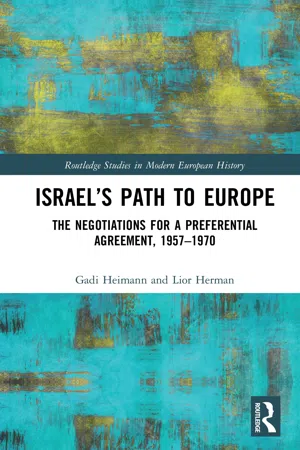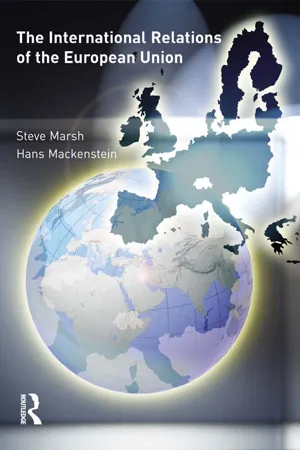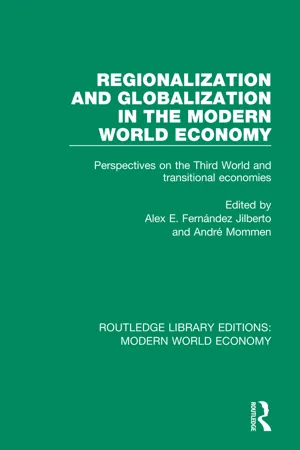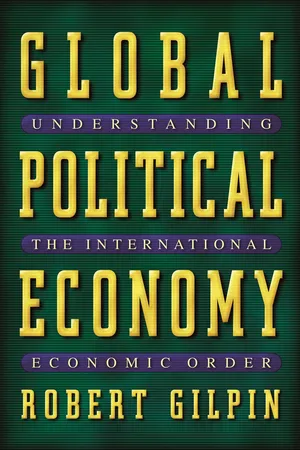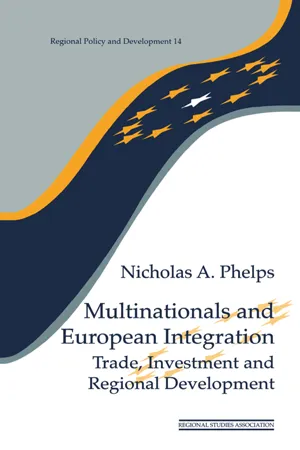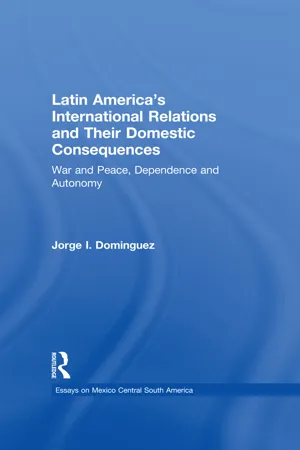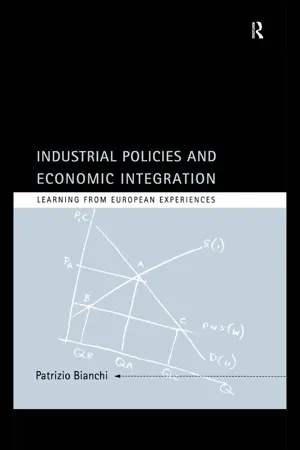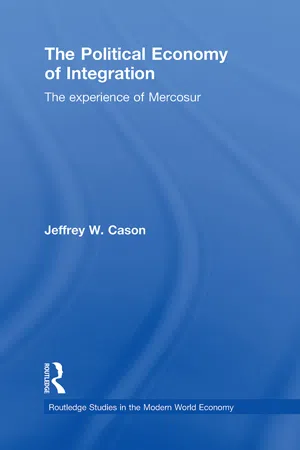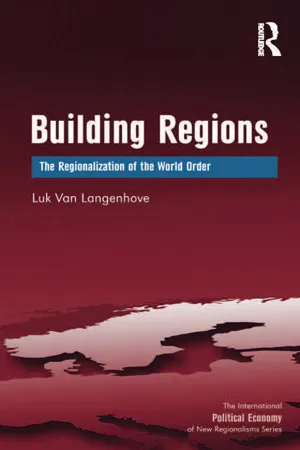History
Economic Integration
Economic integration refers to the process of eliminating trade barriers and coordinating economic policies among different countries. This can involve the creation of a common market, a customs union, or a monetary union. The goal is to promote economic cooperation, increase efficiency, and foster economic growth among the participating nations.
Written by Perlego with AI-assistance
Related key terms
11 Key excerpts on "Economic Integration"
- eBook - ePub
Economic Integration in Asia
Towards the Delineation of a Sustainable Path
- B. Andreosso-O'Callaghan, J. Jaussaud, B. Zolin, B. Andreosso-O'Callaghan, J. Jaussaud, B. Zolin, B. Andreosso-O'Callaghan, J. Jaussaud, B. Zolin(Authors)
- 2014(Publication Date)
- Palgrave Pivot(Publisher)
Contemporary problems in regional Economic Integration seem to be largely dominated by the need to combine growth and economic equality while tackling sustainability issues. During the last two decades, globalization has been a driving force for international trade and foreign investment, of which a large fraction of these movements occurred within large regional areas in Europe, Northern America and Southeast Asia. Simultaneously there has been a dramatic increase in income inequality in all parts of the world (Bourguignon, 2012; OECD, 2011). The sole focus on trade integration as a source of growth cannot thus be the only driver of Economic Integration, as shown by Southeast Asia’s recent experience where large development gaps exist among and within these countries.As Keynes (1926) put it, ‘the political problem of mankind is to combine three things: economic efficiency, social justice and individual liberty.’ A major achievement of the European integration process was to bring the institutions to foster that triad. Given the increase in productive capacity over more than 50 years, it was possible to compromise on economic efficiency and to sacrifice some output. These principles are enshrined in the Treaty on the Functioning of the European Union where the Community aims to ‘promote economic and social progress as well as a high level of employment, and to achieve balanced and sustainable development’ (OJEU, 2010).European history shows that integration is not an end in itself; it is a means to achieve its core objective of growth and prosperity. The main foundations of European Economic Integration were laid down in the Treaty of Rome. The creation of a unifying economic area implied the removal of trade barriers, competition rules to prevent market distortions, capital market liberalization, labour market integration as well as exchange rate and macroeconomic coordination. A major rethinking of the community system took place in the middle of the 1980s with the promotion and furthering of the internal market programme. Gradually, trade liberalization was extended from steal and coal, then to manufacturing goods and a specific market has been organized for agricultural products under the Common Agricultural Policy. However, as external trade increased the pursuit of Economic Integration required the creation of an institutional framework with a system of rules to regulate trade conflicts, which remains one of the distinctive features of the European model (Boyer, 2003). But the path of Economic Integration is explained by ‘domino effect’ processes by which each successive integration increases the pressure on non-participants to join the integration effort and ‘a political economy dynamo set in motion by the unique institutional features established by the 1957 Treaty of Rome’ (Baldwin, 2008). - eBook - ePub
Israel's Path to Europe
The Negotiations for a Preferential Agreement, 1957–1970
- Gadi Heimann, Lior Herman(Authors)
- 2018(Publication Date)
- Routledge(Publisher)
1 The path to Economic Integration This chapter discusses the path to European Economic Integration. It outlines the context, interests, capacities and institutional settings and constraints which are essential in understanding the negotiations between the EEC and Israel. Historical background: the establishment of the European Economic Community In March 1957, at a momentous event, Six West European countries—France, West Germany, 1 Italy and the three Benelux nations—gathered in Rome to sign the Treaty establishing the EEC, the essence of which was the creation of a common market. A common market is one of the most ambitious and far-reaching possibilities for international Economic Integration, 2 far beyond a customs union. Whereas countries in a free trade area eliminate mutual tariffs and cancel trade quotas, membership of a customs union requires in addition the implementation of a common tariff policy vis-à-vis third parties. A common market supplements the customs union with deeper and extensive arrangements: free movement of goods, services, capital and labor. Finally, a common market also involves generating and coordinating common policies in a range of fields, including foreign trade, agriculture, welfare, labor, consumer protection, health and safety and more. 3 Thus, the members of a common market relinquish and share a substantial portion of their economic sovereignty and are precluded from reaching autonomous decisions with regard to considerable policy areas. The high level of integration characteristic of a common market also has far-reaching political significance. In some cases, a political union develops following Economic Integration: both the American and German Federations began as customs unions - eBook - ePub
- Steve Marsh, Hans Mackenstein(Authors)
- 2014(Publication Date)
- Routledge(Publisher)
from regional free-trade arrangement to global economic power?CHAPTER 2The European Economic Community had two overarching aims from the onset: to create a common market and, more generally, to move towards ‘ever closer union’.1 Owing to the particular circumstances of the time, the political ambitions for integration were pursued primarily by way of Economic Integration. The latest and most visible development of such Economic Integration has been the creation and implementation of a common currency: the euro – since 2002 legal tender in twelve of the currently fifteen EU member states.This chapter examines the development of what is now the EU as an economic power, and places this within the context of the global economy. On the one hand, Economic Integration is – in practical terms – a largely inward-looking affair. On the other hand, no such development takes place in a vacuum. European Economic Integration has consequently been partially shaped by the outside world and has itself exerted considerable external influence. With these considerations in mind, it is useful to begin with a historical overview of how the EU evolved first and foremost as an economic entity and then proceed to assess the international framework in which it developed. Finally, the ‘internal’ and the ‘international’ are linked in order to develop a general picture from which to address in later chapters the Union’s role as an international economic actor.Economic Integration – a largely internal affair?As one of the original goals of the EU was to create a common market, it is worth establishing at the onset what this is and how it fits into the progressive development of Economic Integration. Economic Integration theory distinguishes four stages in the movement towards full Economic Integration: the agreement to set up a free trade area (FTA), the move towards a customs union (CU), the establishment of a common market and the eventual creation of full economic union. Each step has certain internal and external effects. The starting point is that there are a number of individual, fully sovereign countries, none of which practise totally free trade. In the absence of free trade there must be so-called trade barriers, which traditionally took the form of tariffs but that more recently comprise also non-tariff barriers (NTBs). These range from quantitative restrictions (quotas) to measures that are perhaps not primarily implemented to hinder trade but still have such an effect, such as certain health and safety standards. In very general terms, a FTA is based on an agreement amongst at least two countries to abolish trade barriers for goods between one another but to maintain their individual trade regimes vis-à-vis - eBook - ePub
Regionalization and Globalization in the Modern World Economy
Perspectives on the Third World and Transitional Economies
- Alex E. Fernández Jilberto, André Mommen, Alex E. Fernández Jilberto, André Mommen(Authors)
- 2017(Publication Date)
- Routledge(Publisher)
In order to suggest answers to these questions, this chapter begins with a presentation of a conceptual framework to analyse the effects of regional Economic Integration. It then proceeds to analyse the former integration in the region, the relation between the new integration and structural adjustment, and the relation between this new integration and the accession to the North American market. This is followed by an evaluation of the effects of some of the main instruments of the integration agreements. The last section presents some final reflections.REGIONAL Economic Integration: A CONCEPTUAL FRAMEWORK
To distinguish them from multilateral trade agreements, regional Economic Integration agreements are known in the literature as preferential trade agreements, limited to a group of countries. Preferential trade agreements can be distinguished according to the degree of Economic Integration they allow. Free trade portes are the simplest forms of Economic Integration, in which the member countries abolish tariffs on reciprocal trade while maintaining their own tariffs for imports from the rest of the world. Customs unions also eliminate tariffs on recíprocal trade between the member countries, but in addition they fix a common external tariff on imports from the rest of the world. Common markets are an advanced form of customs union: in addition to free trade between the members and a common external tariff, they eliminate or reduce restrictions on the movement of productive factors, workers and capital between the member countries. The common market can be reinforced through the coordination of fiscal, monetary and exchange policies.According to the economic literature (Gillis et al. 1996: 531–534), preferential trade agreements can benefit the participants mainly through the emergence of static gains and dynamic gains. Static gains result from the increase in productivity due to the improved allocation of the productive factors. Dynamic or growth gains result from the incentives which arise for investments in production for export and in related industries.The analysis of the static gains distinguishes between trade creation and trade diversion. - eBook - ePub
Global Political Economy
Understanding the International Economic Order
- Robert G. Gilpin(Author)
- 2011(Publication Date)
- Princeton University Press(Publisher)
The modern era has been characterized by integration of small and relatively distinct territories into larger nation-states and into national economies surrounded by trade barriers. Despite this process of Economic Integration, when Fritz Machlup conducted an extensive review of the economic literature in 1976, he learned that prior to 1947 economists had written little about Economic Integration. 6 Such neglect is startling because of the obvious importance of the integration of national markets to the nature and evolution of the world economy. Beginning with the European movement toward Economic Integration in the early post–World War II period, the economics profession began to pay more attention to international integration. Yet theoretical results have been sparse and have not significantly advanced our understanding of the actual process of Economic Integration or of its consequences. In fact, the subject of Economic Integration remains largely empirical rather than theoretical. 7 The principal approaches that economists have taken in their efforts to explain regional integration or free trade areas arise from neoinstitutionalism and the new political economy. The new institutionalism approach assumes that international, including regional, institutions, such as those of Western Europe, are established to overcome market failures, solve coordination problems, and/or eliminate other obstacles to economic cooperation. These institutions create incentives for states to cooperate and, through a variety of mechanisms, to facilitate such cooperation. Although the new institutionalism provides valuable insights, it does not consider the political reasons for regional arrangements - eBook - ePub
Multinationals and European Integration
Trade, Investment and Regional Development
- Nicholas A. Phelps(Author)
- 2013(Publication Date)
- Routledge(Publisher)
CHAPTER 2 The Political Economy of European Integration Regionalism At once the EU stands as the most potent symbol of, and the major force behind, the contemporary regionalisation of trade. The EU’s sphere of influence in world trade has steadily grown to effectively undermine the purpose of the General Agreement on Tariffs and Trade (GATT) and multilateralism. Through both a widening (from the original 6 to the current 15) and deepening, the EU has become the major trade bloc in the world economy; one which has become powerful enough to frustrate the GATT under the leadership of the US. Furthermore, the EU’s influence on world trade does not end there, it extends through its trade relations with much of the rest of the world. Regional Economic Integration can be considered both as a state of affairs and as a process (Balassa, 1962, cited in Chisholm, 1995). Integration as a state of affairs can be conceived in terms of several stages of integration. There are four main stages of Economic Integration which are usually identified – the free trade area, the customs union, the common market and the economic union – though to this list we can add an initial and more general category of the regional trade bloc. The term trade bloc is general enough to encapsulate any of the four formalised states of Economic Integration but also allows one to consider groupings of countries which are not integrated by way of formalised arrangements but rather by de facto trade and investment patterns. Four general conditions make for a coherent trade bloc; similar levels of per capita GNP, geographic proximity, similar or compatible trading regimes, and political commitment to regional organisation (Schott, 1991: 2). As a first stage of regional Economic Integration we may have a collection of countries for which there are no common formal arrangements as in a free trade area but which satisfy the conditions above - eBook - ePub
Latin America's International Relations and Their Domestic Consequences
War and Peace, Dependence and Autonomy,
- Jorge I Dominguez(Author)
- 2014(Publication Date)
- Routledge(Publisher)
Economics and Differential Patterns of Political Integration: Projections About Unity in Latin AmericaERNST B. HAAS AND PHILIPPE C. SCHMITTERECONOMICS AND POLITICS IN REGIONAL INTEGRATIOND OES the Economic Integration of a group of nations automatically trigger political unity? Must economic unions be perceived as “successful” in order to lead to political unification ? Or are the two processes quite distinct, requiring deliberate political steps because purely economic arrangements are generally inadequate for ushering in political unity?There are no unambiguous historical answers. We find few examples of political unity among two or more states antedating the creation of a common market or customs union between them.1 In most acts of federation the initiation of political ties went on simultaneously with the establishment of an actual or potential economic union. The German Zollverein constitutes an exception to this rule; but for other reasons it cannot serve as a guide to an answer.2Recent history alone affords the instances in which voluntary Economic Integration preceded formal or informal steps toward political unity. And even here there is sometimes an articulate political component in the minds of the actors. In western Europe Economic Integration—to some of its partisans—is a deliberate precursor of political unity. All the governments of Central America, with the exception of Costa Rica, take the same position with respect to the Central American Common Market (CACM). But the members of the European Free Trade Association (EFTA) eschew any overt political ambitions. Commentators on the east European Council for Mutual Economic Assistance (COMECON) differ on whether the arrangement has a purely economic function or whether it is part of a larger scheme for a cooperative communist commonwealth. Kenya, Uganda, and Tanganyika have been united in a common market for 37 years and have maintained a common services organization for a number of costly and important administrative functions for almost as long; yet there is evidence of political disintegration in their relations since they achieved independence! Similarly, efforts at sustaining the economic unity of former French West Africa after 1958 resulted in political fragmentation, largely because of the perception of unequal economic benefits and burdens among the units. This negative experience, however, did not prevent these states from attempting a new step toward some measure of pan-African economic unity through the medium of the Organisation Africaine et Malgache de Coopération Economique (OAMCE). The West Indian Federation broke apart for the same reasons as did French West Africa despite the precedence of a certain amount of economic and administrative unity over political union. - eBook - ePub
Industrial Policies and Economic Integration
Learning From European Experiences
- Patrizio Bianchi(Author)
- 2002(Publication Date)
- Routledge(Publisher)
The creation of a common market can therefore provide the conditions for a redistribution of income at the local level that will alter the local conditions of production, encouraging the equalisation of income, but it can also create the conditions for a new distribution of relative advantages of production which accentuates the centre and periphery dichotomy. This polarisation becomes important because new situations of economic dependence that necessarily carry political implications are created.In a case in which the peripheral areas and the central areas coincide with member countries in the economic union, it is evident that this divergent path would establish differences that in time would change the political relationship between the countries taking part in the agreement of Economic Integration.Therefore, there are two views on the effects of an economic union: on the one hand there is a vision of comparative statics which is centred on the tendencies towards convergence in the operative conditions between countries that unite in an economic union; on the other hand there is a dynamic vision that accentuates the possible risks of divergence in the operative conditions connected with a progressive polarisation of development. In the two cases the relationship between national interests and individual interests evolves differently, as we will see in the following discussion.The final phase of economic and political integration is monetary unification. In theory monetary union implies the establishment of a single currency commonly accepted as the unit of exchange in the realm of the economic union; this implies the existence of an international authority which acts as the only issuing entity, collecting common reserves and printing currency. In practice, to have a monetary union it is sufficient to arrange a system of fixed and irrevocable exchanges of currencies among the member countries; this means the establishment of full convertibility and exchangeability of the currencies in any place and at any time, putting aside movements of commodities and of capital in transit between countries participating in the union, as occurs between regions of the same state. Certainly the assumption of a single currency has a fundamental symbolic and practical function, but the crucial element is to compel the individual countries to fix exchanges among themselves in order to permit the use of either currency for whoever operates in the region of the economic union (Emerson 1992). - eBook - ePub
- Brigid Laffan(Author)
- 2005(Publication Date)
- Routledge(Publisher)
Chapter 3 Economic Integration The home market
The decision to complete the home market by 1992 placed the Community’s economic order high on the EC agenda. During the stagnation and low growth of the 1970s, foreign policy co-operation (EPC) was regarded as the model for future European co-operation. The resurgence of formal integration in Western Europe by the mid-1980s owes much to what is known in popular parlance as the ‘1992 programme’. An ambitious legislative programme, it aims to abolish the remaining barriers to economic exchange among the member states of the European Community by the end of 1992. Flanked by EC policies on research and development, the completion of the internal market is central to the achievement of sustained economic recovery in Europe. The apparent dynamism of the programme has contributed to renewed confidence in the EC and has fuelled demands for further Economic Integration in the form of economic and monetary union. A genuine internal market requires such a development. This chapter analyses the changes in the international political economy and in domestic economic policies in the member states that moulded the internal market programme. Attention then turns to the issue of the ‘non-Europe’, the Single European Act and the Cecchini Report. The internal market programme itself is examined from the perspective both of the White Paper and of its dynamic effects on the private sector. The wider dimension of the 1992 programme is addressed in the final section of the chapter.A CHANGING GLOBAL POLITICAL ECONOMY
The 1992 programme must be seen in the context of a global economy that is growing ever more interdependent. Technological developments and related change in business strategy and corporate structure are now international in character. European industry finds itself in a global market, faced with intense competition from the US, Japan and the newly industrializing states. Changing patterns of production and trade have altered economic relations within Western capitalism. The hegemonic position of the US after World War II gave way progressively to a more pluralistic system. The Japanese economy underwent a profound transformation. Japan’s industrial strategy of achieving a high market share in selected sectors proved very successful. In the 1980s a strong export performance in colour television sets, videos, photocopying machines and integrated circuits saw the Japanese penetrating the US and Western European markets. The low propensity of the Japanese to import creates tensions in its relations with the US and Western Europe.1 - eBook - ePub
The Political Economy of Integration
The Experience of Mercosur
- Jeffrey W. Cason(Author)
- 2010(Publication Date)
- Routledge(Publisher)
In order of increasing depth, these would be 1) a free trade area (which provides for free exchange of goods and services between parties to the agreement); 2) a customs union (which includes the former but also has a common external tariff on goods coming from outside the parties to the agreement); 3) a common market (which has a customs union and also the free flow of factors of production, including labor); 4) an economic union (which, in addition to a common market has harmonization of economic policies among member countries); and 5) complete Economic Integration (which has complete unification of all economic policies) (Nye 1971a: 27–30; Balassa 1967). Clearly, different Economic Integration schemes have different goals from the outset. Some, such as the North American Free Trade Area (NAFTA), as it name indicates, is only interested in the first level of Economic Integration, and the unrealized Free Trade Area of the Americas (FTAA) had similar goals. On the other hand, the European Community/Union and Mercosur were much more ambitious; Mercosur’s name— Common Market of the South—reflects this ambition. That said, the ambition of any integration effort does not necessarily match up to reality, as numerous failed attempts at integration indicate. In addition, leaders who sign such accords may be deliberately vague on what they intend and hope to accomplish, either because they disagree among themselves or because their constituencies in their home countries are divided on what integration should accomplish. Nevertheless, this depth dimension is important, as it is important to gauge the intentions (or the range of intentions) of countries that agree to pursue integration. The breadth dimension is related to the depth dimension. By breadth, I do not mean the geographic scope of integration—a frequent use of the term—but rather the scope of policy areas that are subject to negotiation among integration partners - eBook - ePub
Building Regions
The Regionalization of the World Order
- Luk Van Langenhove(Author)
- 2016(Publication Date)
- Routledge(Publisher)
Such half-way integration can be considered as the most important characteristic of the second variety of regional integration. Most free trade arrangements do not have any supra-national structures and have an institutional support that remains rather limited. But as mentioned on page 104, one needs an instrument to rule out trade distortions. And this can only take the form of an independent institution to monitor the market and settle disputes. While the Economic Integration stricto sensu is mostly a story of lifting obstacles, the non-Economic Integration thus easily involves specific institution building or regulations that promote or facilitate integration in fields such as justice, security, culture, education and so on. For instance, if two or more countries want to build a common security policy, this involves not necessarily merging the separate armies but it will necessitate building a common security infrastructure such as a centralized command. The European Union is nowadays the exemplar case of an economic regionalization that has been broadened towards other areas of society because it is believed that a truly Economic Integration cannot be achieved if trade and economy are isolated from the rest of society. As already mentioned some scholars have called this ‘new regionalism’: a form of supra-national regional integration that involves a deep Economic Integration as well as integration in many other domains (Hettne, Inotai and Sunkel 1999). The télos of the second variety of regional integration is thus the unification of what is usually considered to be the ‘internal affairs’ of individual states that is, the provision of public goods. So, in the second variety, the provision of certain public goods shifts from the national to the supra-national regional level. This implies in principle the transfer of part of the national sovereignty
Index pages curate the most relevant extracts from our library of academic textbooks. They’ve been created using an in-house natural language model (NLM), each adding context and meaning to key research topics.

